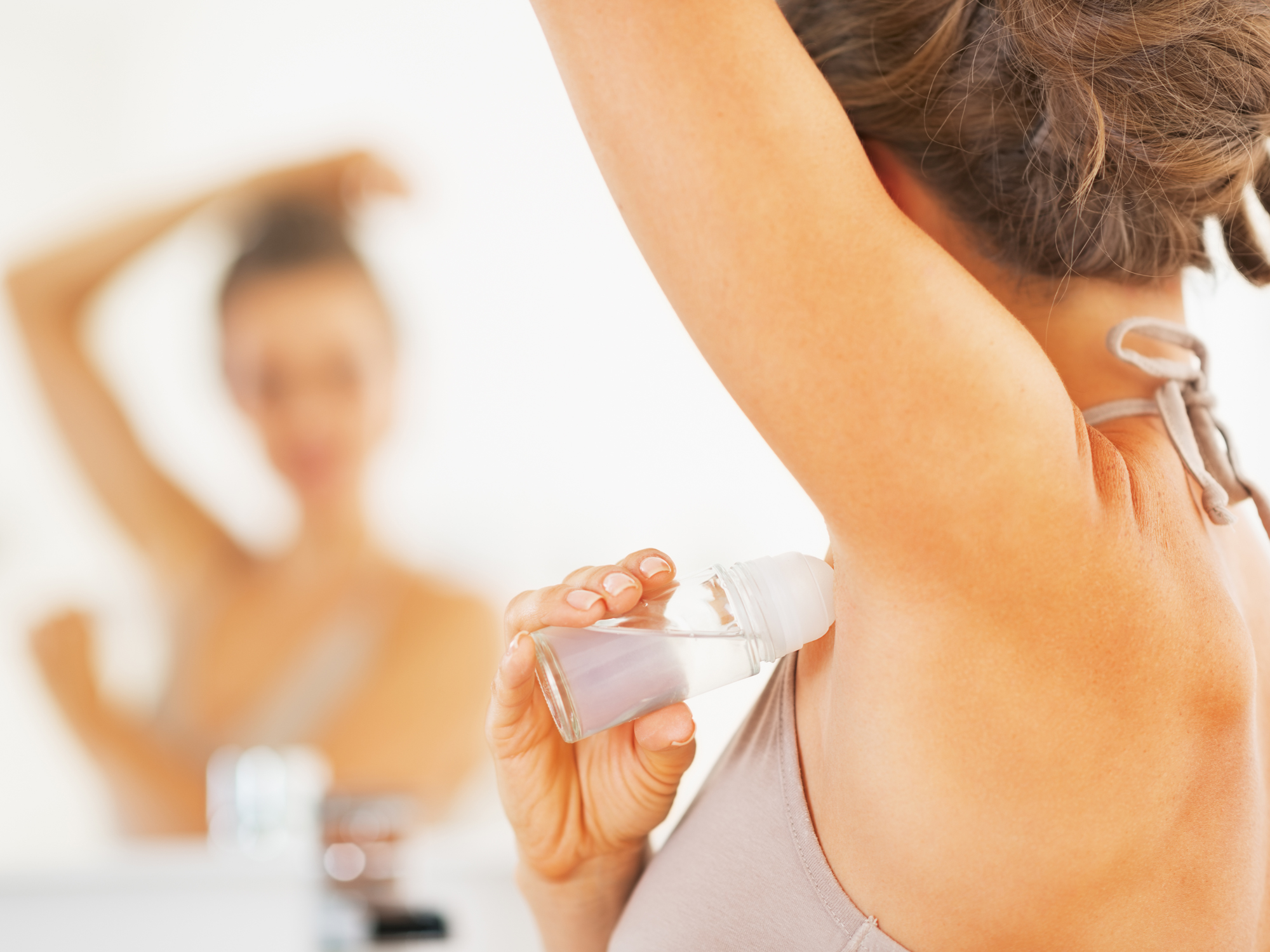Get Easy Health Digest™ in your inbox and don’t miss a thing when you subscribe today. Plus, get the free bonus report, Mother Nature’s Tips, Tricks and Remedies for Cholesterol, Blood Pressure & Blood Sugar as my way of saying welcome to the community!
Avoid the daily dangers causing breast cancer

Chemicals…
They are around you everywhere in this modern world… in your food, the air you breathe, in the cleaning products you use around your home and in the personal care products you apply to your skin — on a daily basis.
While our bodies are quite intelligent and have the capacity to offset chemicals to a certain degree, there is only so much the body can stand before our organs and cells struggle to keep up the pace.
Our exposure to these chemicals begins in childhood and continues throughout our life. So it’s no wonder they have been linked to multiple diseases, including breast cancer…
Everyday chemicals causing breast cancer
Aluminium-containing products — namely, antiperspirant deodorants — have been shown to influence several human breast tissue structures. The FDA does set ingredient limits of around 20-25 percent for the offending aluminium salts included in these products, as this is what is considered ‘safe exposure.’
However, what they have not accounted for is cumulative chronic exposure to these chemicals over the long term. And this is what researchers are extremely concerned about…
Since the application of deodorant to the underarm often begins in early age, and is applied daily, sometimes several times per day, you could definitely say chronic exposure is likely. When skin is newly shaved, irritated, broken or damaged, low levels of aluminium can absorb into the underlying tissues.
Since the underarm is so close to the breast, you can probably guess the consequences…
Studies have found higher levels of aluminium in the outer portions of breast tissue, which researchers believe can trigger breast cancer.
Another common offender is hair dye. Once those grey hairs start appearing, nearly every woman wants to hide them. But hair dyes are toxic. They contain carcinogens that have been linked to a 23 percent increased risk of breast cancer.
Then there’s the food you eat. Exposure to pesticides has been shown to cause toxicity through their disruption of hormones, some with demonstrated estrogenic activity that have been associated with breast cancer development.
Unfortunately, that’s just the tip of the iceberg…
Identifying harmful chemicals
Chemicals that affect your hormones are known as endocrine disrupters, and are especially dangerous. These known disease-causing chemicals should be avoided at all cost…
| Chemical name | Risks | Where they’re found |
| Phthalates (pronounced THAL-ates) | Obesity, respiratory and allergy conditions, altered behavioral development, hormone disruption | Perfume, nail polish, cosmetics, carpets, building materials, children’s plastic toys, cleaning products |
| Phenols – bisphenol A (BPA), triclosan, and parabens | Asthma, altered cognitive and behavioral development, cardiometabolic disorders, hormone disruption | Lining of food cans, plastic bottles, plastic containers, preservatives, mouthwash, cosmetics, dental care items |
| Flame retardants/ Polybrominated diphenyl ethers (PBDEs) | Thyroid hormone disruption, neurological problems, cognitive problems | Upholstered furniture, carpet, synthetic fabrics, wire and cable coatings |
| Perfluorinated compounds (PFCs) | Hormonal disturbances, immune system disruption, increased cholesterol, reproductive system issues | Stain resistant fabrics, some fabric covered furniture, non-stick cookware |
| Organochlorine/ organophosphate pesticides (OCs) | Disruption of hormones, neurotoxin causing nerve impulse problems
|
Personal protective equipment such as gloves and boots; along with residues found on foods and in water |
| Aluminium | Cancer, increased cellular inflammation, DNA changes, Alzheimer’s/ dementia, chronic fatigue syndrome | Personal care products such as deodorants, hair dyes, shampoos, cosmetics, lotions; prepared mixes such as scones and bread mix; antacids. |
8 Ways to minimize exposure to chemicals
1. Eat organic. Since the food you eat can contribute pesticide residues, a great way to start is by choosing organic fruits and vegetables. The worst offenders are strawberries, spinach, nectarines, apples, peaches, pears, cherries, grapes, celery, tomatoes, sweet bell peppers and potatoes. At the very least, purchase these items organically.
Another option is to visit a local farmer’s market to source your produce. Much of the time, local farmers use fewer chemicals than big commercial farming operations.
2. Package food safely. Plastic packaging is troublesome so ensure you choose BPA-free or stainless steel lunch boxes for packaging your foods. Rather than using plastic wrap, when storing foods in the fridge, use BPA-free or glass storage containers and use parchment paper or paper bags to separate lunch box foods.
3. Filter your water. Install a permanent tap filter or purchase a filtering jug to minimize exposure to water-based pesticide residues and harmful chemicals.
4. Stop dying your hair. There’s nothing wrong with grey hair. Be free and let your hair grow out naturally. Though, if that does seem like too much to handle, opt for henna natural hair dyes instead.
5. Choose natural personal care products. You saw from the list above that many of the troublesome items are personal care products you use on an everyday basis. The products that contain fragrances are often the worst offenders, so shop around for natural, organic-based products that use essential oils, or at the very minimum choose fragrance free options.
6. Keep your home furnishings toxin-free. Next time you shop for a mattress, sofa, carpet, pillows, or other fabric-based items, avoid synthetic or stain resistant fabrics and look for products that are free of flame retardants or made with natural materials.
7. Purchase natural cleaning products. Shop for more natural, less toxic cleaning products. Or even better, make your own from simple ingredients such as vinegar, lemon, tea tree oil, lemon oil, vegetable soap, and bicarbonate soda.
8. Wash your hands. Since there are chemicals everywhere, washing your hands regularly can minimize cross contamination.
It can be difficult to completely eliminate chemical exposure, but every little thing you do can help reduce your risk of developing diseases such as cancer.
Editor’s note: Detoxing is an important protocol to cleanse the risk of cancer from your body. Discover the best techniques, plus additional natural therapies and cancer-fighting supplements, vitamins and foods to avoid and beat cancer in Dr. Michael Cutler’s guide, Surviving Cancer. Get your copy and free reports today!
Sources:
- Darbe PD, et al. Aluminium and breast cancer: Sources of exposure, tissue measurements and mechanisms of toxicological actions on breast biology. Journal of Inorganic Biochemistry. 2013;128:257-261.
- Sifakis S, et al. Human exposure to endocrine disrupting chemicals: effects on the male and female reproductive systems. Environ Toxicol Pharmacol. 2017;51:56-70.
- Dailymail.co.uk. (2017). Mail Online. Retrieved 20 March, 2017, from http://www.dailymail.co.uk/health/article-4300782/Changing-colour-hair-linked-breast-cancer.html
- EWG.org. (2017). Retrieved 28 March, 2017 from https://www.ewg.org/foodnews/dirty_dozen_list.php
- Projecttendr.com. (2017). Resources. Retrieved 20 March, 2017, from http://projecttendr.com/resources/
- Priestly B. (2017). Health effects of perfluorinated compounds. Retrieved 20 March, 2017, from http://www.airservicesaustralia.com/wp-content/uploads/Brian-Priestly_FINAL.pdf












